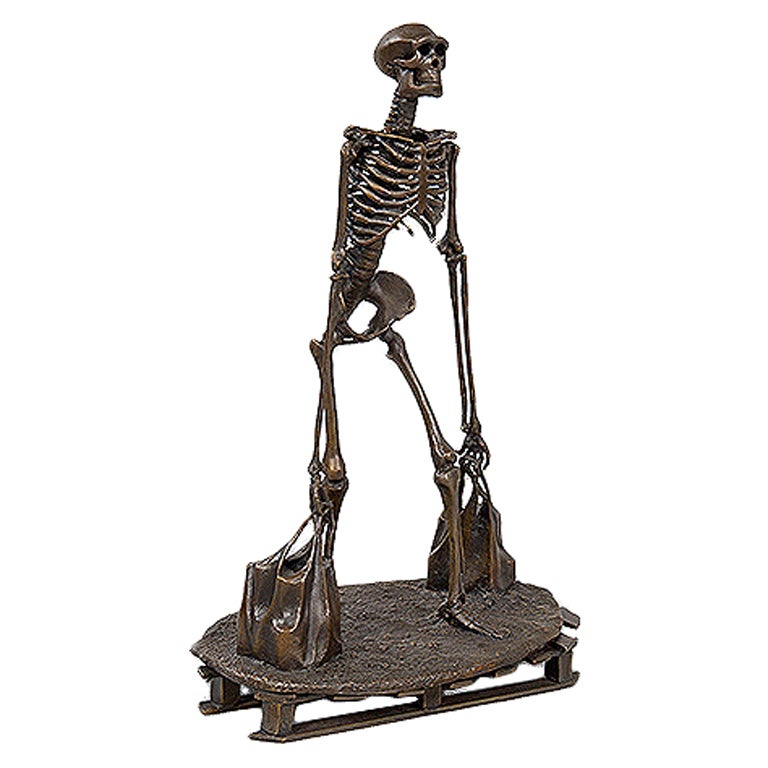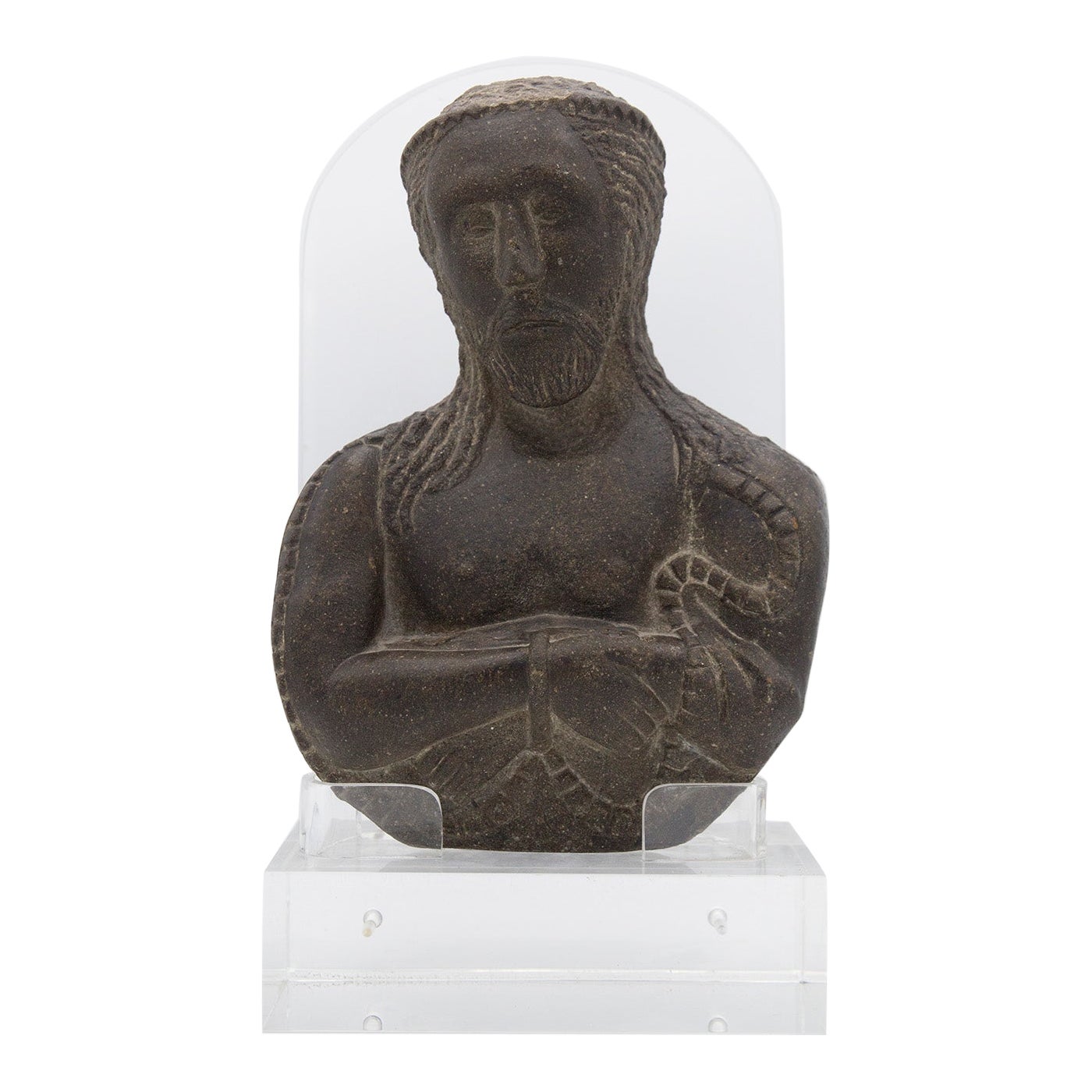Items Similar to End of 16th Century Ecce Homo Sculpture Papier-mâché and Terracotta
Want more images or videos?
Request additional images or videos from the seller
1 of 12
End of 16th Century Ecce Homo Sculpture Papier-mâché and Terracotta
About the Item
Late 16th - early 17th century Ecce Homo
Papier-mâché and terracotta, cm alt. 56 x depth 29 x width. (base) 43
The Christ, represented half-length while reaching forward with his arms crossed with his wrists superimposed towards his executioners, depicted with his face declined on the right side and with the distraught and mystical gaze turned downwards, accepts his destiny as Salvator mundi . This is the phrase that according to the vernacular Pontius Pilate, then Roman governor of Judea, addressed to his people, showing them Jesus scourged. According to the Gospels, Jesus, at the time of his arrest, was found innocent by the Governor. The latter, to calm the Jews who wanted to see Jesus executed anyway, finally had him scourged, thus thinking of satisfying the bloodthirsty of the public. After the scourging Pilate showed the Jews the Christ covered with wounds and bleeding wounds, with a crown of thorns on his head, a purple king's cloak on his shoulders and a cane scepter in his hands and uttered the phrase "Ecce Homo" as if to say "Look at the Man, do you see that I punished him?". However, this was not judged sufficient and the high priests pressed for the prisoner to be crucified.
The materials with which the work is made are papier-mâché and terracotta, by shaping the body of the Lord they make even more evident the signs of the torture and sacrifice he made to save humanity, getting closer to the person concerned and giving a strong emotional impact to the composition.
The compositional trait is fine and accurate in the beard and hair, in the arched and nervous hands, in the intense realism and patheticism of the face.
The sculpture is part of the production of figures linked to the sacred representations of Holy Week and shows a strong dependence on central Italian figurative examples, close to Tuscan culture.
- Dimensions:Height: 22.05 in (56 cm)Width: 16.93 in (43 cm)Depth: 11.42 in (29 cm)
- Materials and Techniques:
- Place of Origin:
- Period:Early 17th Century
- Date of Manufacture:End of 16th Century
- Condition:Refinished. Wear consistent with age and use.
- Seller Location:Milan, IT
- Reference Number:1stDibs: LU5918226765772

About the Seller
5.0
Vetted Seller
These experienced sellers undergo a comprehensive evaluation by our team of in-house experts.
Established in 2000
1stDibs seller since 2021
25 sales on 1stDibs
Typical response time: 12 hours
- ShippingRetrieving quote...Ships From: Milan, Italy
- Return PolicyA return for this item may be initiated within 14 days of delivery.
More From This SellerView All
- 19th Century Madonna and Child with Souls in Purgatory Papier-Mache SculptureLocated in Milan, ITFirst half of the 19th century Madonna and Child with souls in Purgatory Lacquered and gilded papier-mache with polychrome wooden base cm 96.5 x 37.5 x 28 "At that time I asked the Lord Jesus: 'For whom do I still have to pray?'. Jesus answered me that the following night he would make me known for whom I had to pray. I saw the Custodian Angel, who ordered me to follow him. At a moment I found myself in a foggy place, invaded by fire and, in it, a huge crowd of suffering souls. These souls pray with great fervour, but without effectiveness for themselves: only we can help them. The flames that burned them, they did not touch me. My Guardian Angel did not abandon me for a moment. And I asked those souls what their greatest torment was. And they unanimously answered me that their greatest torment is the ardent desire of God. I read the Madonna who visited the souls of Purgatory. The souls call Mary 'Star of the Sea'. She brings them refreshment ". (Diary of Sister Faustina Kowalska p. 11) A Polish religious, Saint Faustina Kowalska (1905-1938) reinterpreted in the pages of her testimony the ancient role of the Virgin as savior and supporter of the souls of Purgatory. The Second Vatican Ecumenical Council established that, assumed into Heaven, the Mother of God should operate a continuous intercession in favor of those children waiting for Paradise who were in the place, quoted for the first time by Pope Gregory the Great...Category
Antique Early 19th Century Italian Figurative Sculptures
MaterialsPaper
- 18th Century Immaculate Madonna Terracotta SculptureLocated in Milan, IT18th century Immaculate Madonna Terracotta, 53 x 22 x 20 cm The work examined depicts the Virgin Mary treated according to the iconography of the Immaculate Virgin The theme of the Immaculate Conception began to appear in artistic works ever since the debate began, which saw the Franciscans and the ramifications of the Benedictine Order lined up on one side, linked to the thought of Anselmo d'Aosta and Bonaventura da Bagnoregio, and on the other the Dominicans, linked to the discussion offered by Thomas Aquinas...Category
Antique 18th Century European Figurative Sculptures
MaterialsTerracotta
- Terracotta sculpture with bust of togatus Adolfo LaurentiLocated in Milan, ITAdolfo Laurenti (Monte Porzio Catone, April 23, 1858 - Rome, 1944) Bust of togatus Terracotta, 21 x 18 x 12 cm Adolfo Laurenti was born on April 23, 1858, in Monte Porzio (since 1...Category
Antique 19th Century Italian Figurative Sculptures
MaterialsTerracotta
- Adoration of the Magi in polychrome terracotta, 17th centuryLocated in Milan, ITXVII Century Adoration of the Magi Polychrome terracotta, 24 x 18 cm The present relief, made of terracotta that retains the original polychromy, depicts the famous episode in the...Category
Antique 17th Century Figurative Sculptures
MaterialsPottery
- Bronze sculptures Nereid and Triton 19th centuryLocated in Milan, IT19thC Nereid and Triton (2) Bronze and marble, cm h. 26.5 The pair of sculptures depicts the river deities identifiable in Triton, recognizable by his scepter, and one of the Nereid...Category
Antique 19th Century Figurative Sculptures
MaterialsBronze
- Sculpture depicting Dante and Beatrice, Alabaster, 20th centuryLocated in Milan, ITDante and Beatrice Alabaster, 33 x 20 x 36 cm Early 20th century The present alabaster relief, of which great technical skill is evident, imitates the pages of a book, On the two...Category
20th Century Figurative Sculptures
MaterialsAlabaster
You May Also Like
- Ecce Homo. Sculptor active in Lombardy, mid-16th centuryBy Non-Standard Furniture and LightingLocated in Milano, ITWooden sculpture depicting Ecce Homo. Christ, whose figure is cut off at thigh level, is standing, arms crossed at waist level. Long ringlets frame a face with a pointed beard, a hal...Category
Antique 16th Century Italian Other Figurative Sculptures
MaterialsWood
- Ecce Homo - Florence, 15th centuryLocated in Bruxelles, BEA terracotta bust "Ecce Homo" Florence, 15th century 53 x 44 x 31 cmCategory
Antique 15th Century and Earlier Italian Renaissance Figurative Sculptures
MaterialsTerracotta
- "Ecce Homo Tesco" Sculpture, England, 2011By Shaun Doyle & Mally MallinsonLocated in London, GB"Ecce Homo Tesco" sculpture, England, 2011. Edition 3/9 by Shaun Doyle & Mally Mallinson, signed "Mally Doyle" We aren’t going to be drawn into a discussion a...Category
21st Century and Contemporary English Sculptures
MaterialsBronze
- 16th century polychrome wood sculptureLocated in Firenze, ITImportant 16th-century polychrome and gilded wood carving depicting Saint, Italy. The work features exceptional gilding on the dress and hair. Extremely important is the size of th...Category
Antique 16th Century Italian Figurative Sculptures
MaterialsWood
- 16th CENTURY MARBLE SCULPTURE OF A YOUNG HERCULESLocated in Firenze, FISplendid sculpture in white Carrara marble depicting a young Hercules holding the world. Originally, the work was conceived to be used as a caryatid at the beginning of a sumptuous m...Category
Antique 16th Century Italian Renaissance Figurative Sculptures
MaterialsCarrara Marble
- A 16th century carved marble sculpture of poseidonLocated in London, GBThis fine and imposing sculpture is an excellent example of 16th century Italian craftsmanship. The figure is stood on a raised, shaped rectangular base with a carved "dolphin" at th...Category
Antique 16th Century Italian Renaissance Figurative Sculptures
MaterialsMarble





